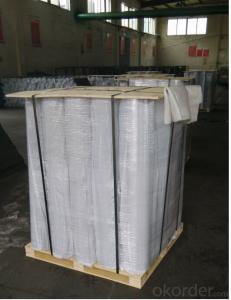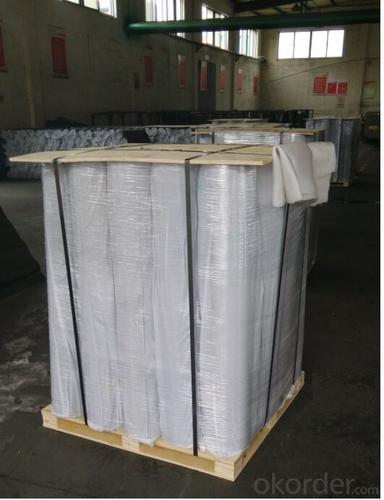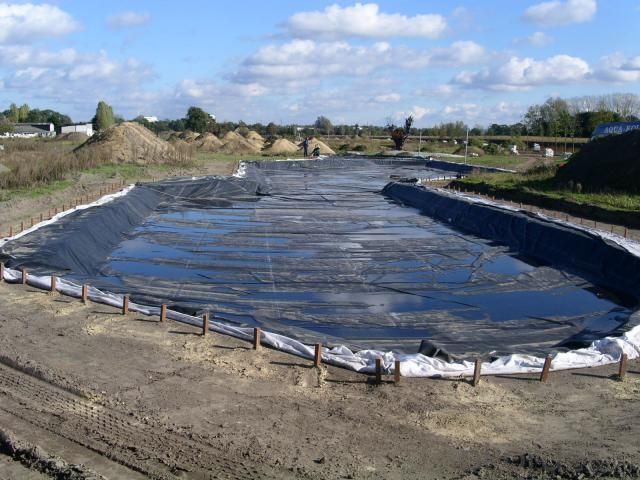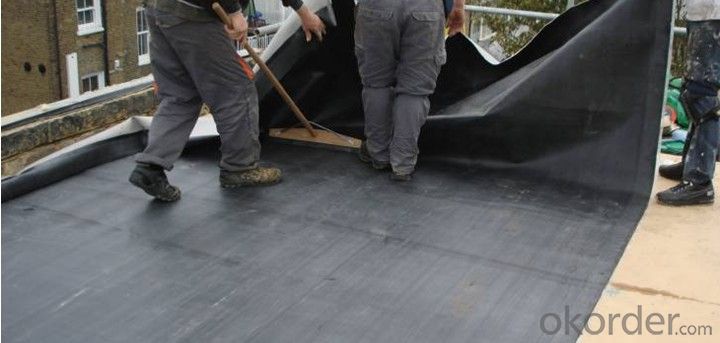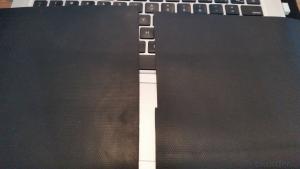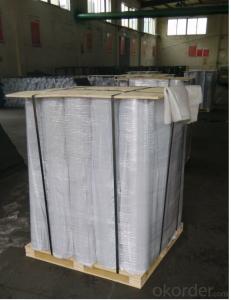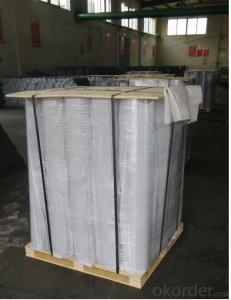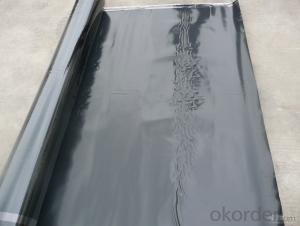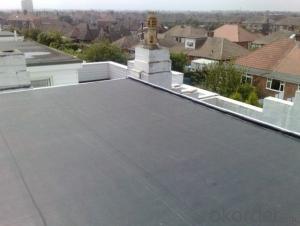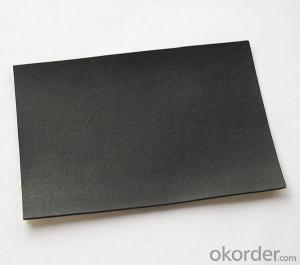EPDM Rubber Coiled Waterproof Membrane for Pallet Packing
- Loading Port:
- Shanghai
- Payment Terms:
- TT OR LC
- Min Order Qty:
- 50000 m²
- Supply Capability:
- 5000000 m²/month
OKorder Service Pledge
OKorder Financial Service
You Might Also Like
EPDM Rubber Coiled Waterproof Membrane for Pallet Packing
Description Of EPDM Rubber Coiled Waterproof Membrane for Pallet Packing:
•EPDM waterproof sheet has excellent anti-ozone-aging performance, able to resist ultraviolet light and corrosion of many chemical corrosive materials in the atmosphere
•It has high tensile strength, high ductility and strong retractility, it has excellent crack resistance, able to effect waterproof function even with tiny vibration of buildings.
• Excellent resistance to ozone, oxidation and sunlight.
• Resistance to chemicals; resistant to most inorganic products.
Main Features of EPDM Rubber Coiled Waterproof Membrane for Pallet Packing:
1>Excellent antiaging performance, service life up to 50 years
2>Working well with in 40C to 100C,it canbe constructed with a single layer in ambient temperature.
3>Waterproofing on various kinds of underground project,industrial of civil buildings and structures.
4>high extension rate, high tensile strength, small size changes at heat treatment
5>Good plant roots penetrability resistance and can be made waterproofing layer of planting roof
6>Special modified molecular structure ,effectively resolving the current domestic and foreign glue joint problem.
7>Good low temperature flexibility, and good performance of adapting to ambient temperature changes.
8>Convenient application ,solid joint, no environment pollution
9>chemical corrosion Resistance, can be used for special occasions
10>Convenient maitenance, low cost.
Specifications of EPDM Rubber Coiled Waterproof Membrane for Pallet Packing:
| Material | EPDM Rubber |
| Size | 1.2m (width)*20m (length) or customized, weldable type 2.05m or 4m width |
| Thick | 1.2mm, 1.5mm, 2.0mm |
| Type | Vulcanized & Weldable |
| Pattern | Non-reinforced (homogeneous) |
| Certificate | ISO9001/14001 |
Applications of EPDM Rubber Coiled Waterproof Membrane for Pallet Packing:
Widely used in roofs, basement, toilet ,swimming pool, and all kinds of industry and civil building waterproofing, reservoir, vivicism, bridge, underground, tunnel and dam waterproofing ,especially to the keystone waterproofing projects which is durability, high corrosion resistance and easy deformation.



IMages of EPDM Rubber Coiled Waterproof Membrane for Pallet Packing:




FAQ of EPDM Rubber Coiled Waterproof Membrane for Pallet Packing:
1. What are we supplying?
We are specialized in producing Colorful Asphalt Roof Shingle, SBS/APP modified bitumen waterproof membrane, Self adhesive bitumen waterproof membrane, PVC waterproofing membrane, EPDM rubber roofing membrane, Single Component Polyurethane Waterproof Coating, and Spray Polyurea Waterproof Coating
.
2. How Many years experience do we have?
We have been exported to more than 20 countries in the past 15 years.
3. How long do we usually reply your request?
We always reply our customer within 24 hours.
- Q: Can a waterproofing membrane be used in areas with vehicular traffic?
- Yes, a waterproofing membrane can be used in areas with vehicular traffic. Waterproofing membranes are designed to provide a protective barrier against water infiltration and can be applied in various settings, including areas exposed to vehicular traffic. However, it is important to choose a membrane that is specifically designed for heavy-duty or high-traffic areas to ensure its durability and effectiveness.
- Q: Can a waterproofing membrane be used for marinas and boat docks?
- Yes, a waterproofing membrane can be used for marinas and boat docks. Waterproofing membranes are designed to create a barrier against water penetration, making them an ideal solution to protect structures such as marinas and boat docks from water damage and corrosion. These membranes provide a durable and long-lasting waterproofing solution that can withstand the harsh marine environment.
- Q: Can waterproofing membranes be used on underground structures?
- Indeed, underground structures can make use of waterproofing membranes. These membranes have been designed with the aim of creating a barrier against water infiltration and are widely utilized in various applications, including basements, tunnels, and underground parking lots. The main objective of employing waterproofing membranes in underground structures is to avert water penetration, as this can lead to structural damage and compromise stability. Generally, these membranes are crafted from materials like modified bitumen, PVC, EPDM, or HDPE, all of which possess outstanding water resistance properties. By applying waterproofing membranes correctly, a continuous and robust barrier is established, preventing water from seeping through the walls, floors, or foundations of underground structures. These membranes can be installed externally or, on occasion, as an integral part of the concrete walls or floors during construction. In addition to their water resistance capabilities, waterproofing membranes also offer protection against other elements such as chemicals, gases, and radon. They prove highly effective in preventing issues related to moisture, like the growth of mold, the deterioration of building materials, and structural damage, thus ensuring the durability and integrity of underground structures. It is crucial to bear in mind that the proper installation and maintenance of waterproofing membranes are of utmost importance for their effectiveness. It is advisable to engage the services of a qualified professional who can assess the specific requirements of the underground structure and recommend the appropriate type of waterproofing membrane and installation method. All in all, waterproofing membranes serve as a dependable and efficient solution for preventing water infiltration in underground structures, providing long-lasting protection and preserving the structural integrity of the building.
- Q: How does a waterproofing membrane handle water pressure from below?
- A waterproofing membrane handles water pressure from below by creating a barrier that prevents water from seeping through. It is designed to withstand the pressure exerted by water, ensuring that it remains intact and does not allow water to penetrate into the structure it is protecting.
- Q: Can a waterproofing membrane be used on stucco surfaces?
- Yes, a waterproofing membrane can be used on stucco surfaces. Waterproofing membranes are often applied to stucco surfaces to protect them from water damage and enhance their durability. These membranes create a barrier that prevents water from seeping into the stucco, helping to maintain its integrity and preventing moisture-related issues such as cracking or mold growth.
- Q: Can waterproofing membranes be used on plant rooms?
- Yes, waterproofing membranes can be used on plant rooms. Waterproofing membranes are often used in areas where water resistance is necessary, such as basements, roofs, and plant rooms. Plant rooms typically house various mechanical and electrical equipment, and using waterproofing membranes can help protect these sensitive components from water damage.
- Q: Can a waterproofing membrane be used on concrete slabs or foundations?
- Yes, a waterproofing membrane can be used on concrete slabs or foundations. It serves as a protective barrier against water penetration, preventing moisture-related issues such as leaks, mold, and structural damage. The membrane is typically applied to the exterior surface of the concrete to create a waterproof seal.
- Q: Can a waterproofing membrane be used in swimming pools?
- Indeed, the utilization of a waterproofing membrane in swimming pools is widespread. To avert water leakage, it is a customary practice to incorporate waterproofing membranes during the construction or refurbishment of swimming pools. These membranes possess an exclusive design that enables them to function as a barrier against water infiltration, guaranteeing the pool's impermeability and leak-free condition. Typically, these membranes are crafted from robust materials like PVC, EPDM, or polyurethane, which exhibit resistance to water, chemicals, and UV rays. Furthermore, their flexibility allows them to effortlessly conform to the pool's shape and contours, providing a seamless and enduring waterproofing solution.
- Q: Can a waterproofing membrane be used on terrazzo surfaces?
- Yes, a waterproofing membrane can be used on terrazzo surfaces. Terrazzo is a durable and versatile flooring material made from a combination of marble, granite, quartz, or glass chips embedded in a cementitious or epoxy matrix. While terrazzo is generally resistant to water, it is not completely waterproof and can absorb moisture if left untreated. Applying a waterproofing membrane on terrazzo surfaces can help protect it from water damage, staining, and discoloration. The membrane acts as a barrier, preventing water and other liquids from seeping into the terrazzo, thus enhancing its longevity and maintaining its aesthetic appearance. It is important to ensure that the waterproofing membrane is compatible with the terrazzo material and is applied according to the manufacturer's instructions for optimal effectiveness.
- Q: Can a waterproofing membrane be used for a planter box wall?
- Indeed, a planter box wall can benefit from the application of a waterproofing membrane. This specialized membrane is specifically designed to create a barrier against water infiltration, making it an excellent choice for a planter box wall where moisture is present. By employing a waterproofing membrane on the interior surface of the planter box, one can effectively safeguard the wall against moisture-related harm and prevent water from seeping into the adjacent soil. This proactive measure not only prolongs the lifespan of the planter box but also mitigates the risk of water damage to the surrounding area. However, it is imperative to ensure that the chosen waterproofing membrane is compatible with the materials utilized in the construction of the planter box and to adhere to the manufacturer's instructions for proper installation.
Send your message to us
EPDM Rubber Coiled Waterproof Membrane for Pallet Packing
- Loading Port:
- Shanghai
- Payment Terms:
- TT OR LC
- Min Order Qty:
- 50000 m²
- Supply Capability:
- 5000000 m²/month
OKorder Service Pledge
OKorder Financial Service
Similar products
Hot products
Hot Searches
Related keywords
